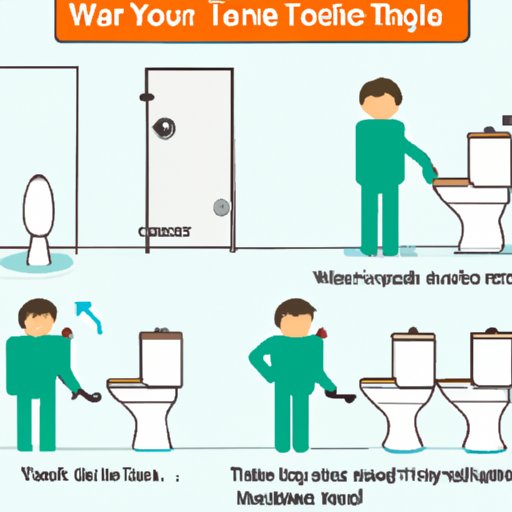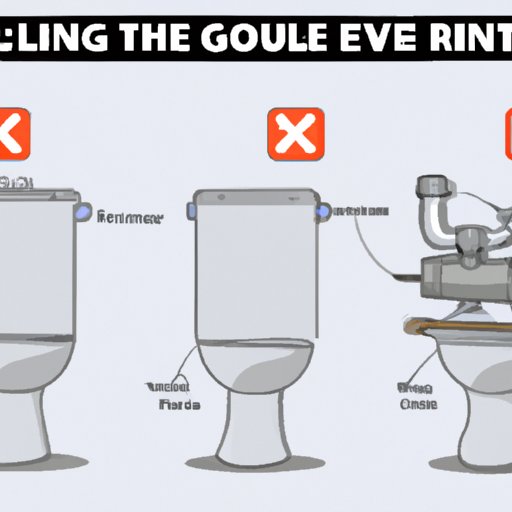
Introduction
There’s nothing more annoying than a toilet that won’t stop running. Not only is it a disturbance, but it’s also a waste of water and can increase your utility bill. Fixing a running toilet is easier than you might think, and with a few tools and some tips, you can do it yourself. This article will guide you through common causes, solutions, and tips for fixing a running toilet.
Common Causes of Running Toilets and How to Fix Them
The main reason a toilet keeps running is that the flapper valve is not sealing correctly. This means water keeps flowing from the tank to the bowl, causing the toilet to run continually. In some cases, the fill valve, overflow tube, or flapper chain may be the cause of a running toilet.
How to inspect and diagnose each issue:
- Flapper valve: Take off the toilet tank lid, flush the toilet, and observe whether the flapper is causing the running problem by not sealing the valve. It may not be closing correctly. If it doesn’t seal correctly, the water will run continuously. To fix, bend the flapper to sit more securely or replace it.
- Fill valve: Turn off the water supply, flush to drain the tank, and remove the fill valve cap. Inspect the valve for damage, debris, or obstructions and inspect the water level. Adjust the water level as necessary to the recommended fill level on the valve.
- Overflow tube: Clean the overflow tube of debris and ensure it is not obstructed. Adjust the water level to around one inch below the overflow tube.
- Flapper chain: Ensure the chain is not too long or short. Adjust to the correct slack so that the flapper can seal correctly.
Detailed instructions on how to fix each issue:
- Flapper valve: Drain the tank, remove the flapper from the valve, clean the flapper and valve seat, and replace the flapper if necessary.
- Fill valve: Remove the cap and clean or replace the fill valve as necessary.
- Overflow tube: Clean obstructions and adjust the water level to recommended fill level.
- Flapper chain: Adjust the slack to ensure it’s neither too long nor short.
Illustrations to support the explanation:


DIY Guide to Fixing a Running Toilet
This section will give you a step-by-step guide to diagnosing and repairing different types of running toilet problems. You’ll also find a comprehensive list of tools and materials needed and tips for troubleshooting along the way.
Tools Needed:
- Screwdriver
- Adjustable wrench
- Bucket
- Pliers
- Replacement parts as necessary
Step-by-step guide:
- Identify the cause of the running toilet. Refer to the previous section to diagnose and fix the issue.
- Turn off the water supply to the toilet.
- Flush the toilet to drain the tank.
- Remove the lid from the tank.
- If necessary, remove and clean the flapper valve or replace with a new one.
- Inspect and clean the fill valve, overflow tube, and flapper chain accordingly.
- Reassemble the parts as needed.
- Turn the water back on and fill the tank to the recommended level.
- Flush the toilet to ensure the running has stopped.
Tips for troubleshooting along the way:
- Take photos of the internal parts of the toilet to ensure you know what they look like before taking them apart.
- Check that any replacement parts are compatible with your model of toilet.
Illustrations to support the explanation:

Saving Water and Money: How to Fix a Running Toilet
It’s essential to fix a running toilet to conserve water and save money. A running toilet can waste up to 200 gallons of water per day, which can be costly.
To fix the problem, turn off the water supply to the toilet and follow the steps outlined earlier in this article. The repairs are usually straightforward and can save you a lot of money and reduce unnecessary water wastage.
Top Hacks for Troubleshooting Running Toilets
Here are some common reasons for running toilets and how to troubleshoot them:
- Jiggling the handle: If the handle sticks or does not return after flushing, a simple jiggle may adjust the chain or lift to seal the valve.
- Adjusting the chain: Check that the chain connecting the lift to the flapper valve is not too long or short.
- Tightening the screws: Check that all the screws are tight on the toilet and the tank.
Illustrations to support the explanation:

Common Mistakes that Can Keep Your Toilet Running
Here are some common mistakes people make when fixing running toilets:
- Using the wrong replacement parts
- Failing to properly adjust the water level
- Not cleaning the parts properly before replacing them
To avoid these mistakes, ensure that you have the correct replacement parts and follow the manufacturer’s instructions for installation. Clean all the parts appropriately before replacing them to make the repairs effective.
When to Call a Plumber to Fix Your Running Toilet
Not all toilet issues can be resolved at home, and sometimes calling a plumber is the best option. Here are some signs to look out for:
- Persistent leaks
- Cracked tank or bowl
- Damaged pipes
- Tree roots damaging the plumbing system
If you notice any of these signs, don’t hesitate to call a professional plumber for assistance.
Conclusion
Fixing a running toilet is essential to conserve water and save money on utility bills. The common causes and solutions are straightforward to diagnose and fix at home with the correct tools and replacement parts. Follow the tips and guides outlined in this article, and don’t hesitate to call a plumber for assistance if necessary.





